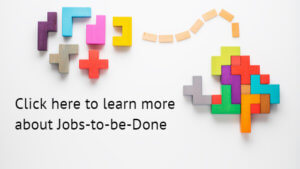Who is your customer? The Importance of Roles for JTBD

Mediocre product teams ask the question, “How do we improve our product?” Good teams ask, “For what job does a customer hire our product?” But the elite teams additionally ask, “Who are we creating value for?” And to arrive at a proper answer, we must understand customer roles for JTBD (jobs-to-be-done).
What are the Roles for JTBD?
In short, the JTBD roles describe the potential customer types within an ecosystem. In this article, Anwar Abulizi describes the three components within a JTBD ecosystem: jobs, products and customers. The job is the “what”. It’s the thing to be accomplished. The product is the “how”. It’s the mechanism for accomplishing the job. The customer is the “who”. This is the person seeking to accomplish the job.
And so, what are the roles for JTBD? JTBD roles are the defined actors within a JTBD ecosystem. The typical roles are job executor, job beneficiary, job overseer, purchase executor and purchase influencer.
Here are the definitions as defined within The Statue in the Stone: Decoding Customer Motivation with the 48 Laws of JTBD Philosophy:
- Job Executor: Person who executes a JTBD
- Job Beneficiary: Person who enjoys the benefits of a JTBD
- Job Overseer: Person responsible for the results of a JTBD
- Purchase Executor: Person who performs the JTBD “Purchase a product”
- Purchase Influencer: Person who performs the JTBD “Influence a purchase”
Do we need this formality to define the roles for JTBD?
We really do. Jobs-to-be-done is powerful because of the precision in which it can be used to define a market and the opportunities within. Unfortunately, some find the abstract-sounding names such as “job executor” to be off-putting. For some, this starts to sound a bit theoretical. Perhaps, too academic.
However, for the folks that have concerns about the practicality, I only need to point them to the confounding challenges within the worlds of marketing, innovation, and new product development. They will find that defining roles for JTBD is a key step in decoding these market riddles. Consider these representative examples of an enduring puzzle:
Lighting Fixtures
Your company makes lighting fixtures for commercial office buildings. Who is your customer? Is it the person slaving away under the fluorescent bulbs? Is it the facilities manager of that building? Or maybe, is it the electrical contractor who installs fixtures? Or perhaps, we should think about the architect who designed the building. But what about the interior designer? What about the distributor?
Outdoor Fabrics
Your company makes fibers that go into outdoor fabrics for usage in tents, backpacks, etc. Who is your customer? Is it the person who purchases the tent? Or is it the textile firm that weaves it into the fabric? And then, how do we account for the retailers who sell tents and backpacks? They likely have some needs as well.
Dog Food
Your company makes dog food. Who is your customer? Perhaps, we’d begin with people who have dogs. But what if the person who feeds the dog is not the same person who purchases the food? Additionally, what do we do with veterinarians, who could be influential about what food is purchased, even though their own purchasing power is modest?

A familiar challenge
Likely, you recognize the problem within your own markets. And in truth, during AIM’s New Product Blueprinting workshops, one of the most common questions, once distilled down, is “Who is my customer?” Frequently, it comes to light when aspiring VoC (voice of customer) practitioners are sorting through who they should interview to uncover customer needs.
And unfortunately, I’m sorry to report that the answer to this question, “Who is my customer?” may take some exploration. However, the process begins with defining the market, using JTBD (jobs-to-be-done) terms. Let’s take these terms of job executor, job beneficiary, job overseer, purchase executor, and purchase influencer, and use them to dissect the dog food example.
The Dog Food Market: Who is your customer?
Your company makes dog food. You’re the product manager for the X17 project, which will result in a new product for older, overweight, large breeds. Who is your customer?
Using the JTBD approach, we begin with a job-to-be-done. After some analysis, we arrive at the job statement to feed the dog. From there, we determine what the roles for JTBD are. The logical one, to begin with, is the job executor. That is, who feeds the dog? To keep things simple, let’s image personas within a family. (If unfamiliar with the persona method to define archetypes within a market, you may find this article of interest.) Our persona for the person who feeds the dog is Junior, a 12-year old boy.
Enter Junior, our Job Executor
Junior arises each morning to walk the dog. Soon after, he locates the dog food, pours it in the bowl, and waits until after the dog has finished eating. After a bit of clean-up, Junior’s finished. However we, in our task to assign job roles, are not.
Next, the purchase executor. Meet Mom. As the inventory control manager of the household, she purchases dog food within the rotation of her other shopping duties.
Next, we look to the job overseer. This person doesn’t perform the job, but is responsible for the results. Moreover, Mom is also our job overseer. She’s not involved with the day-to-day feeding. However, she’ll notice if the feeding area is clean after the event each morning. Additionally, she’ll notice if the dog is getting too fat or too skinny. To help determine this, she confers with the veterinarian, who fills the next job role, the purchase influencer.

The vet doesn’t feed the dog, isn’t responsible for the results, and doesn’t buy food. However, he consults with Mom about the dog’s health and provides recommendations. And on occasion, these recommendations will refer to the dog’s food and eating habits. The vet influences the purchase decision.
Are we finished? Have we listed all the job roles? Almost. We still have the job beneficiary, the person (or in this case, the animal) who benefits from the job. And our beneficiary is the dog. Perhaps, not the best interview target. But with ingenuity and some testing, it’s still likely you could learn something of the dog’s preferences.
Who is our customer?
On one hand, we still have some thinking to do in order to answer this question. But as a start, we have all the stakeholders identified. In practice, it’s common to realize that we may need to pursue more than one. That is, we might want to understand the needs of more than one actor within the job roles. The more roles that are pursued for voice of customer (VoC), the more complete the image will be of the total ecosystem. However, more stakeholders also require more time and effort. Therefore, it can be tricky to evaluate the risks vs rewards for the number of stakeholders to include.
Who to pursue?
Let’s suppose that in this situation, we decide to pursue all of them. However, note that the job statement can vary slightly for each one. And this job statement will become the focus for VoC within that specific stakeholder group. But, we’re making progress. We’re getting close. Once we have the job statement, we know the nature of our VoC questions:
Job executor
- Job executor: Junior
- Job: Feed the dog
- VoC questions: What challenges do you have when feeding the dog?
Job overseer
- Job overseer: Mom
- Job: Oversee the job of feeding the dog
- VoC questions: What challenges do you have when overseeing the job of feeding the dog?
Purchase executor
- Purchase executor: Mom
- Job: Purchase dog food
- VoC questions: What challenges do you have when purchasing dog food?
Purchase influencer
- Purchase influencer: Vet
- Product: Dog food
- VoC questions: What challenges do you have when recommending dog food?
Job beneficiary
- Job beneficiary: The dog
- Job: Eat the food (Or, being fed)
- VoC questions: What challenges do you have when eating dog food?
Which customers should we pursue? Who is our customer?
In practice, of course, the selected role(s) will vary. Nearly always, however, we’d begin with the job executor at a minimum. So, in our dog food case, we would almost certainly investigate Junior’s needs as he feeds the dog. From there, it can be a long and difficult conversation to select the other stakeholders.

The main reason this is difficult is there’s a hidden implication of the selection regarding your innovation timeframe. With extremely long-term objectives, such as developing entirely new technologies, it makes sense to study the job beneficiary and job overseer. These groups are both “customers” of the results of the job, and therefore, distant technologies will bend towards their needs.
However, if your goals are in the realm of product strategies, such as to develop a brand new product or to develop a roadmap for future products, then you’ll study the job executor. This person will have the best information about the challenges of accomplishing the job today.
Further, when the goals are quite short-term in nature, such as to increase sales next year, or to develop new marketing messages, then we should include the purchase influencer and purchase executor.
Why is it difficult to select which roles of JTBD to pursue?
For starters, the roles are often not even identified. Therefore, we can’t even negotiate the previous dialogue about stakeholders. Next, many project sponsors and team members will have different priorities regarding short-term marketing goals as opposed to long-term strategic objectives. Third, if not using a JTBD framework, folks will not be self-aware enough that these priority variances of multiple timeframes are driving their assertions around the question, “Who is our customer to pursue?” Finally, even if we do have all this awareness, there will still be uncertainty about who to select.
In real innovation projects, the answer is often to study multiple job roles. But when we do, we must proceed knowing what insight that each group can best provide. Job beneficiaries, overseers, and executors provide reconnaissance for strategic objectives. Product purchasers and influencers provide insight for shorter-term sales and marketing objectives.
Define Job Roles for JTBD and Meet your Customers
The topic of job roles is a funny one within the innovation literature. It’s not a topic that you really find until diving deep into JTBD esoterica. And even then, it just seems like we have these unimportant-sounding little definitions. Job executor, job overseer, job beneficiary, and whatnot.
But this is unfortunate. If not taking the time to define the job roles within your markets, quite frankly, your license as a JTBD practitioner should be revoked! It’s great that we identify the job that customer hires our product for. But it’s just as important to identify who the customer is. So, then the question “Who is your customer?” is one that you’ll want to become proficient at exploring.
To that end, one final bit of counsel. More often than not, this question takes more time and discussion than most predict. Set the expectation upfront with your teams that it will take some effort, and schedule plenty of time for that discussion to happen. With an understanding of the JTBD, and with a list of targeted JTBD roles, success is about as inevitable as it can be.

Comments